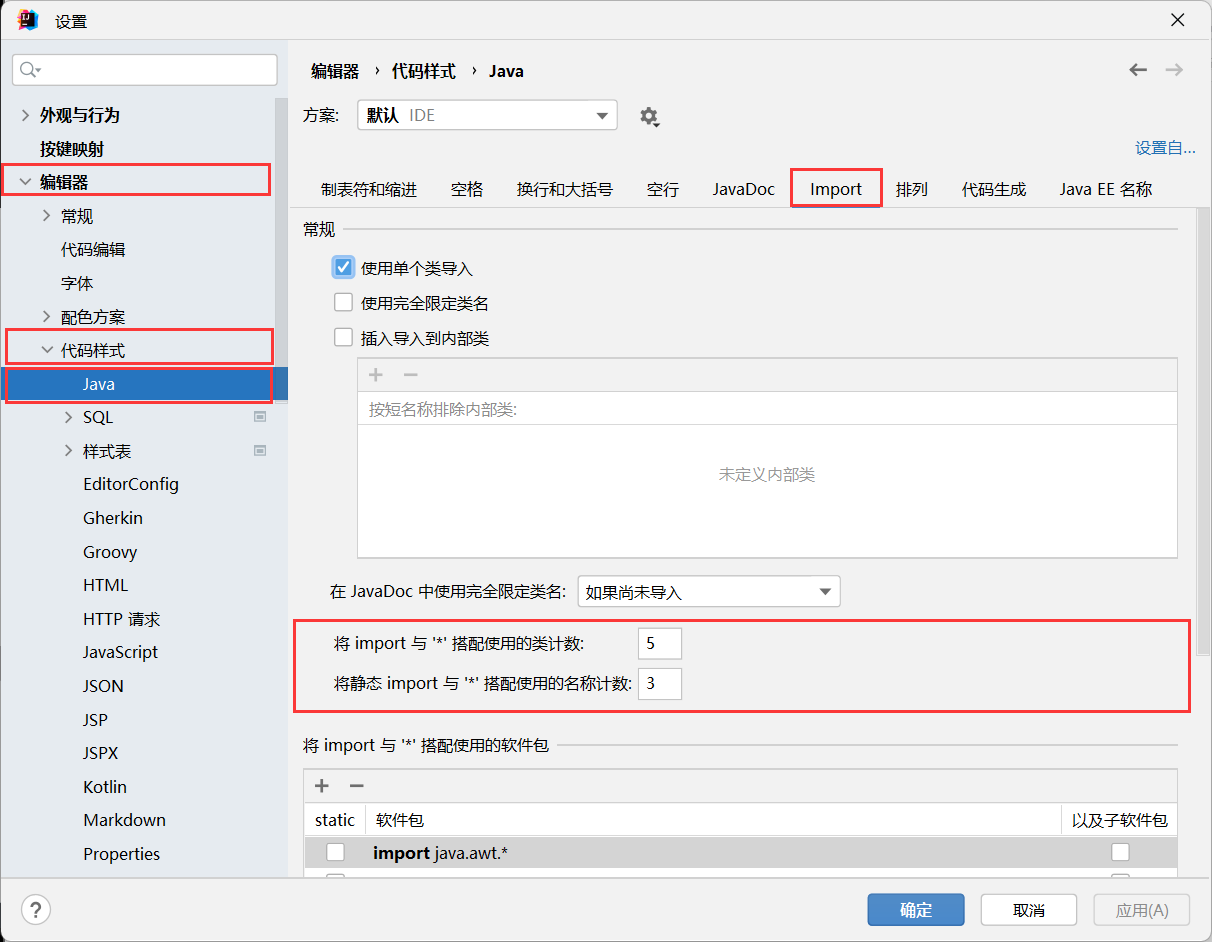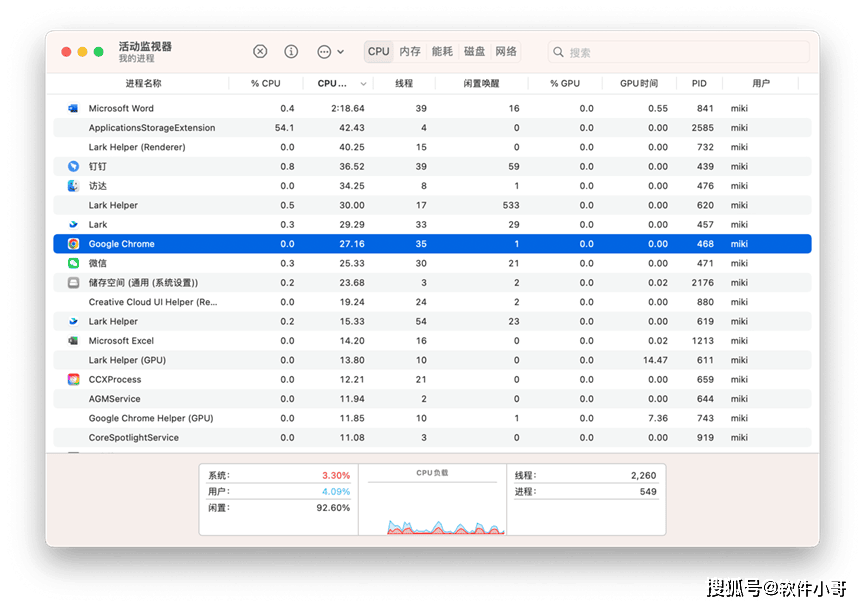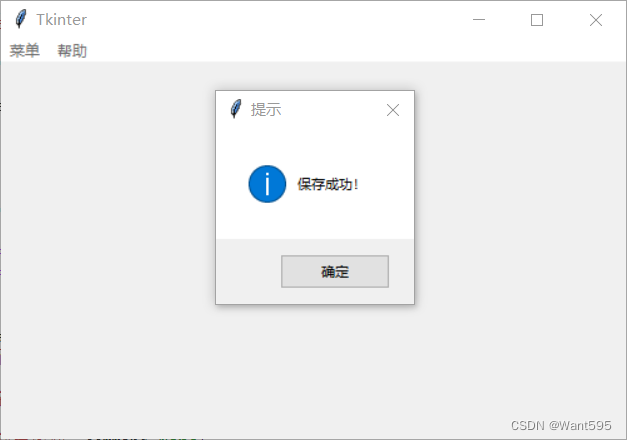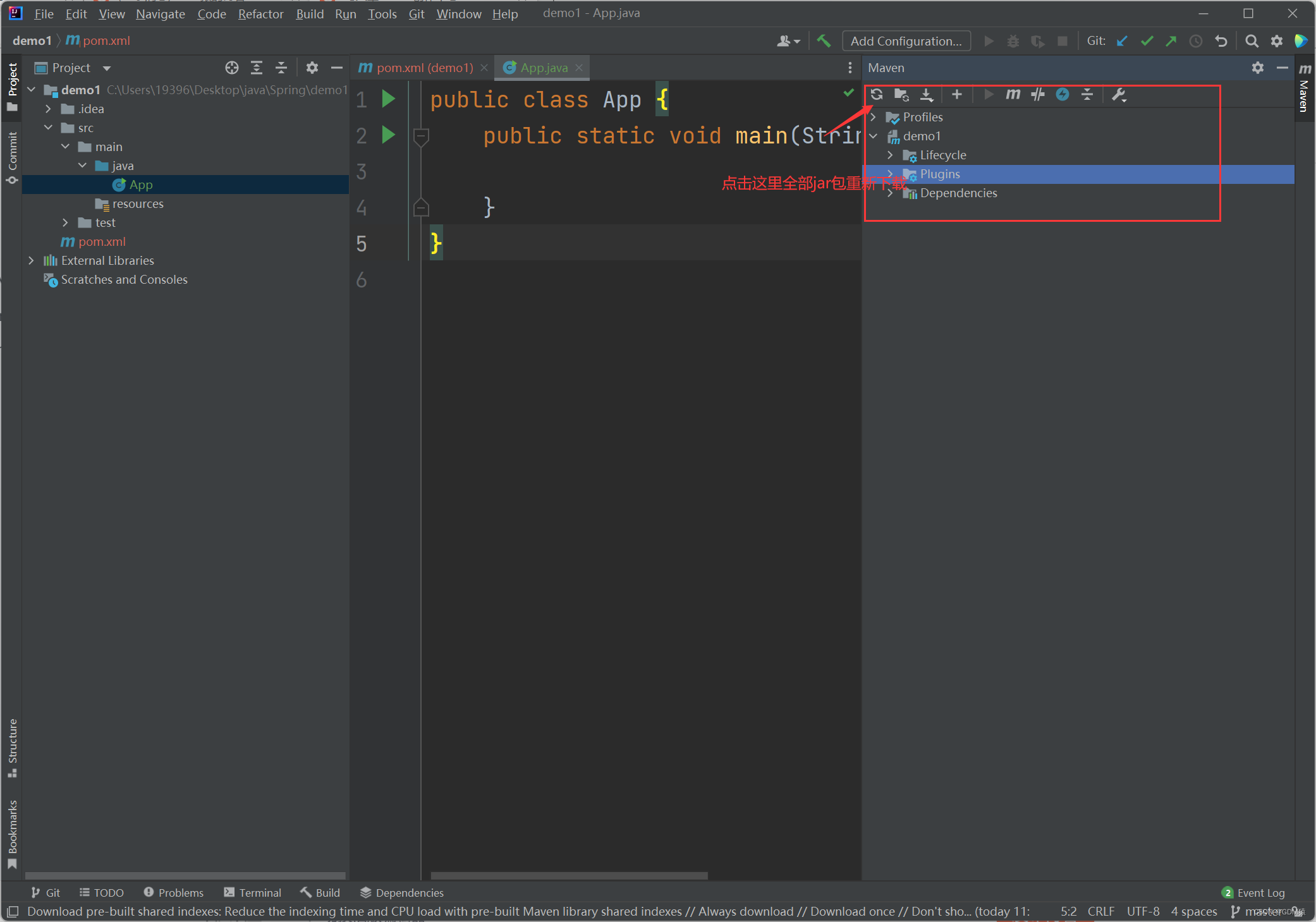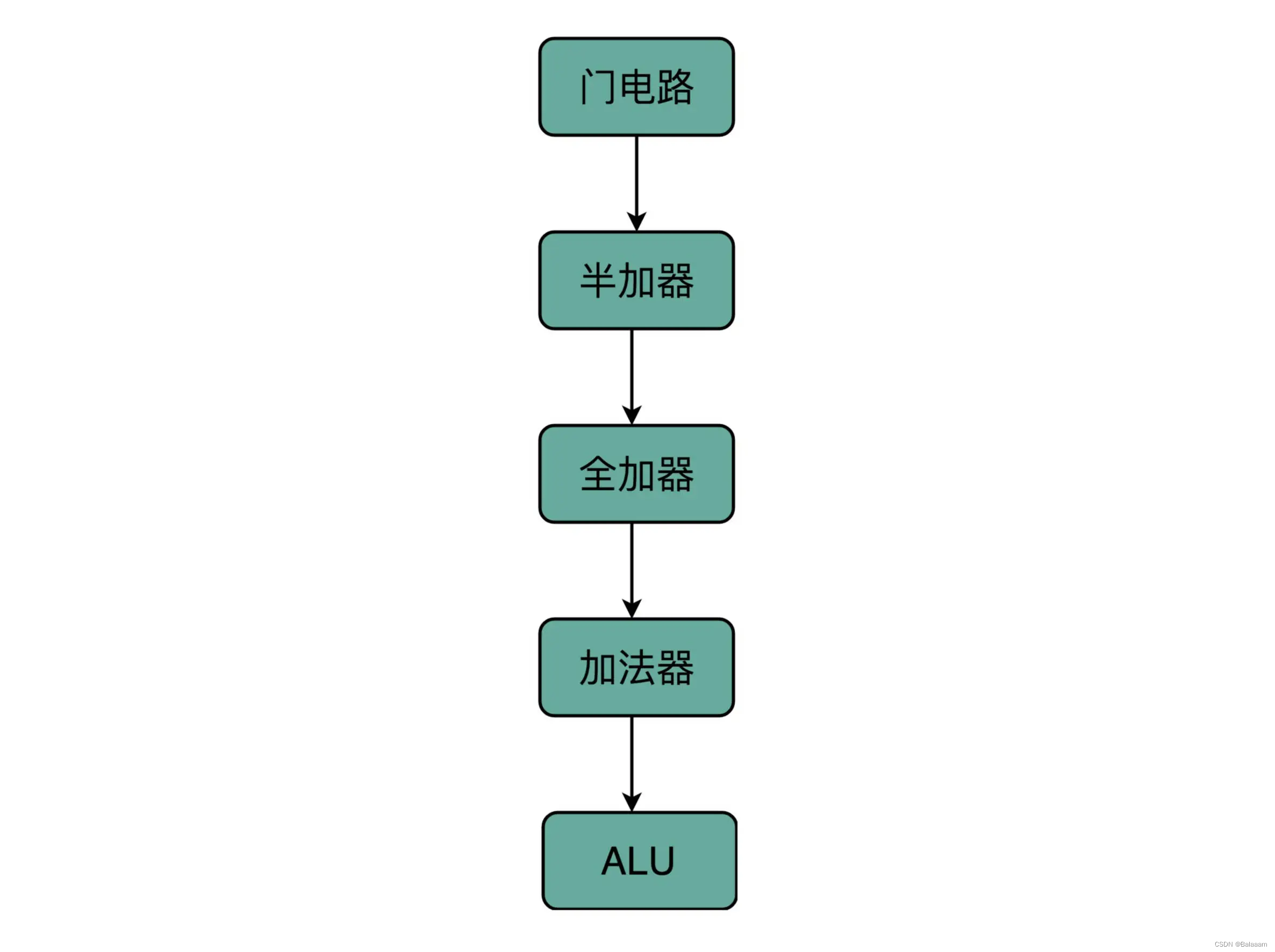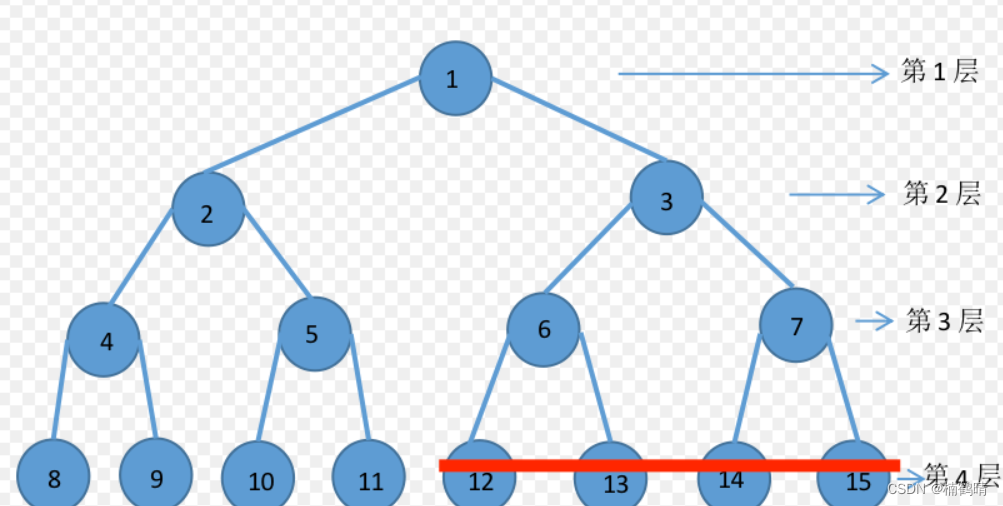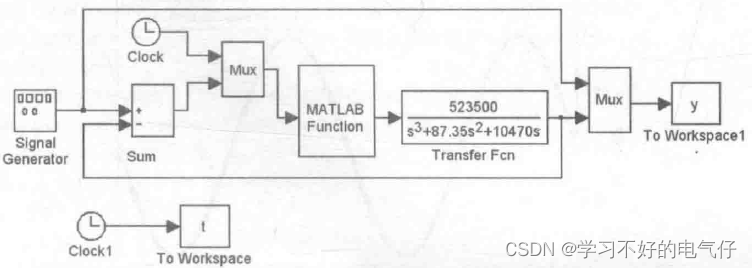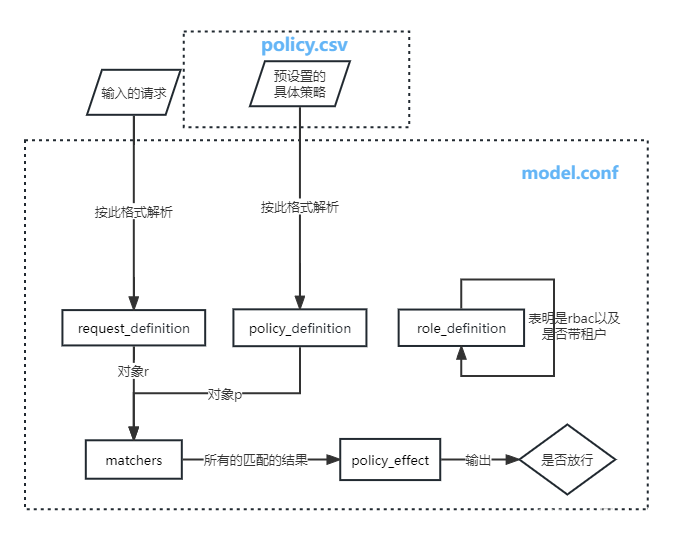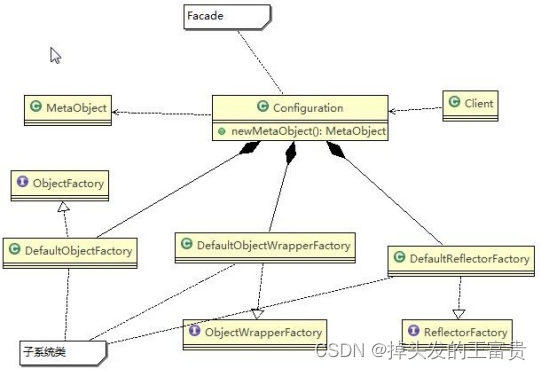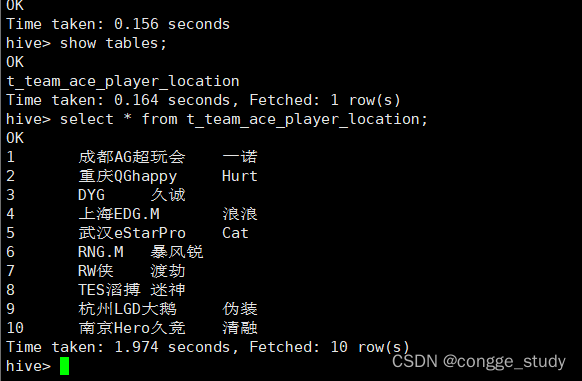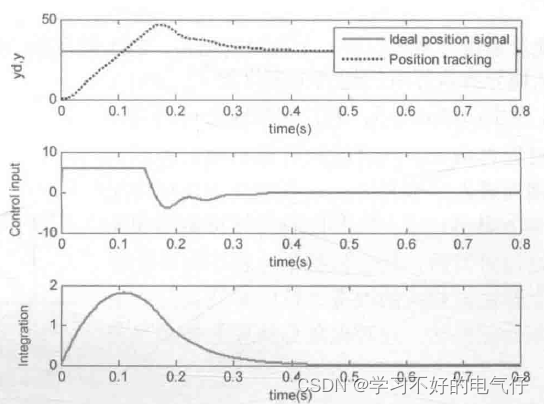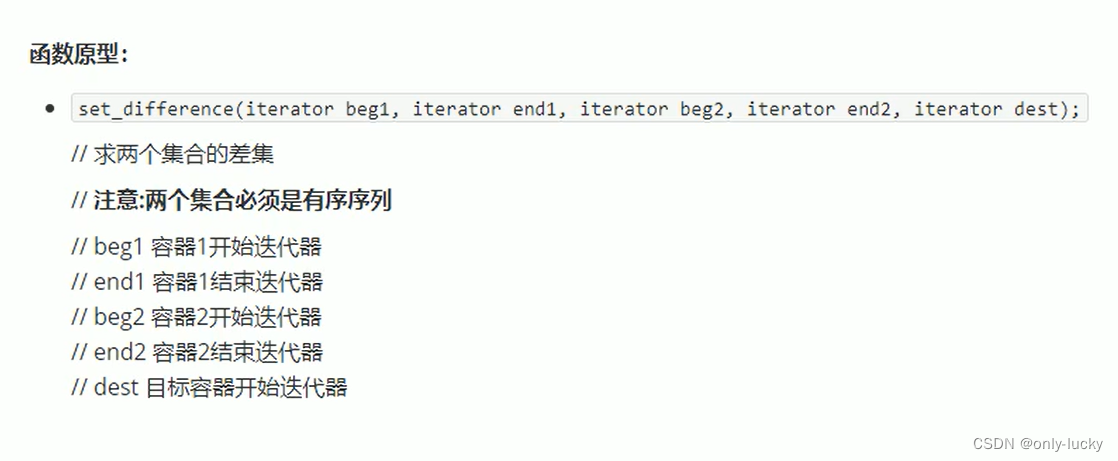基于学习的状态修剪策略
- 1.引言
- 2.Homi算法
- 2.1.概率修剪策略
- 2.2.Homi
- 2.2.1.Collecting Promising Data
- 2.2.2.Generating Features.
- 2.2.3.Learning Distribution
- 2.2.4.Sampling Values
- 2.2.5.总结
- 3.实验
- 3.1.实验设置
- 3.2.有效性
- 3.3.候选状态数量
- 3.4.与朴素方法的对比
- 4.代码实操
- 4.1.代码运行
- 4.2.Run_KLEE
- 4.3.Run_Gcov
- 4.4.Feature_Extractor
- 4.5.PruningStgy_Generator
- 5.参考文献
- 6.其它示例
- 6.1.kquery
- 6.2.feature_data内容
- gcov示例
在这篇paper中,作者提出了Homi 算法,在运行时通过修剪掉不必要(unpromising)的状态来增强符号执行工具。
1.引言
下图是符号执行算法的形式化描述,红框为作者添加的部分:
-
每个状态可以用3元组 ( i n s t r , s t o r e , Φ ) (instr, store, \Phi) (instr,store,Φ) 描述:
-
i n s t r instr instr 为将要执行的指令。
-
s t o r e store store 为将程序变量映射为符号值的map。
-
Φ \Phi Φ 为当前状态对应的路径条件。
-
-
每个测试用例用2元组 ( Φ , M o d e l ( Φ ) ) (\Phi, Model(\Phi)) (Φ,Model(Φ)) 描述, M o d e l ( Φ ) Model(\Phi) Model(Φ) 为对应输入。
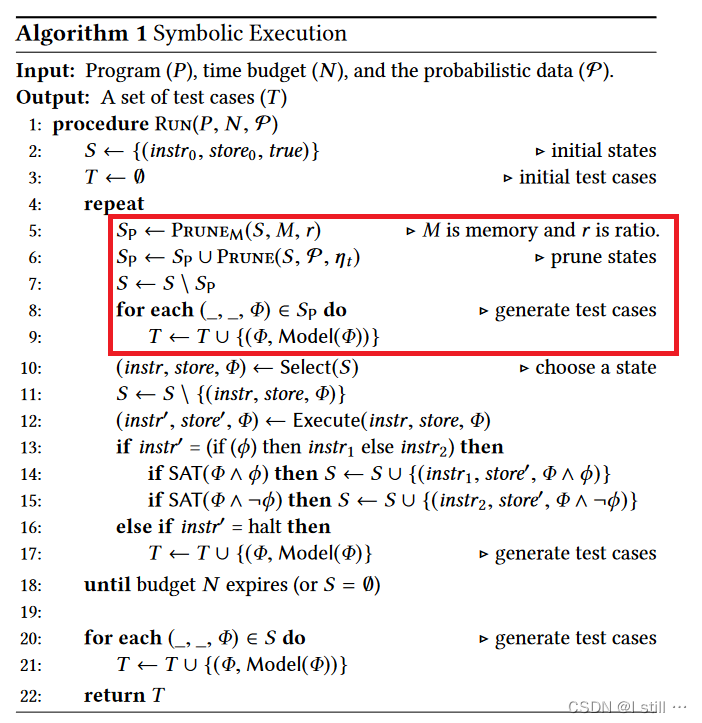
在这篇paper中,作者认为有意义(promising)的状态是那些可以提高分支覆盖率的状态,因此需要修剪掉不必要的状态。那么需要解决的问题有:
-
如何衡量每个状态的重要程度?计算状态分数
-
要修剪掉多少状态? 计算修剪得数量
2.Homi算法
2.1.概率修剪策略
修剪策略大体上可分为2步:
-
sampling: 计算概率数据 P P P, P P P 由3元组 ( F , P s t g y , P r a t i o ) (F, P_{stgy}, P_{ratio}) (F,Pstgy,Pratio) 构成。
-
F F F 表示一个n维特征集合,每一维表示一个core branch condition,用来计算一个状态的特征向量。
-
P s t g y P_{stgy} Pstgy 是n维向量 θ \theta θ 的概率分布, θ \theta θ 用于计算每个状态的分数。每次调用 P R U N E ( S , P , η t ) PRUNE(S, P, \eta_t) PRUNE(S,P,ηt) 都会根据 P s t g y P_{stgy} Pstgy 重新sample出一个 θ \theta θ 向量。
-
P r a t i o P_{ratio} Pratio 是修剪比例 r r r 的概率分布, r r r 用于决定要修剪的状态数量。每次调用 P R U N E ( S , P , η t ) PRUNE(S, P, \eta_t) PRUNE(S,P,ηt) 都会根据 P r a t i o P_{ratio} Pratio 重新sample出一个 r r r 值。
-
-
pruning:修剪函数如下面公式所示,说白了,就是选取bottom-k分数的状态修剪掉,
k = |Sp * r|。
P R U N E ( S , P , η t ) = { arg min S p ⊆ S ⋀ ∣ S p ∣ = S ∗ r ∑ s ∈ S p s c o r e ( s , θ ) i f ( F ≠ ∅ ) ∅ o t h e r w i s e PRUNE(S, P, \eta_t) = \left\{ \begin{array}{rcl} \argmin\limits_{S_p \subseteq S \bigwedge |S_p| = S * r} \sum\limits_{s \in S_p} score(s, \theta) & & {if (F \; \neq \; \empty)} \\ \empty & & {otherwise}\\ \end{array} \right. PRUNE(S,P,ηt)={Sp⊆S⋀∣Sp∣=S∗rargmins∈Sp∑score(s,θ)∅if(F=∅)otherwise
上述过程针对每个状态:
- 首先将状态转换成1个特征向量,每个特征表示一个布尔谓词,用于检查状态
s的路径条件 Φ \Phi Φ 是否包含特定的分支条件 ϕ \phi ϕ。形式化定义如下,即如果当前s的路径条件包括条件表达式 ϕ i \phi_i ϕi( ϕ i \phi_i ϕi 为 F F F 中第i个core branch condition),那么特征向量第i维为1,否则为0。其完整特征向量 f e a t ( s ) = < f e a t 1 ( s ) , . . . , f e a t n ( s ) > feat(s) = <feat_1(s), ..., feat_n(s)> feat(s)=<feat1(s),...,featn(s)>。
f e a t i ( s ) = { 1 i f ( ϕ i i n Φ ) 0 o t h e r w i s e feat_i(s) = \left\{ \begin{array}{rcl} 1 & & {if (\phi_i \; in \; \Phi)} \\ 0 & & {otherwise}\\ \end{array} \right. feati(s)={10if(ϕiinΦ)otherwise
-
之后通过概率分布 P s t g y P_{stgy} Pstgy 可sample出 θ \theta θ, s c o r e ( s , θ ) = f e a t ( s ) . θ score(s, \theta) = feat(s) . \theta score(s,θ)=feat(s).θ。比如 θ = < 0.4 , − 0.82 , − 0.3 > , f e a t ( s ) = ⟨ 1 , 0 , 0 ⟩ \theta = <0.4, −0.82, −0.3>, feat(s) = ⟨1, 0, 0⟩ θ=<0.4,−0.82,−0.3>,feat(s)=⟨1,0,0⟩,那么 s c o r e = 0.4 score = 0.4 score=0.4。
-
然后从概率分布 P r a t i o P_{ratio} Pratio sample出修剪状态的比例 r r r,修剪掉
bottom-|Sp * r|的状态。
2.2.Homi
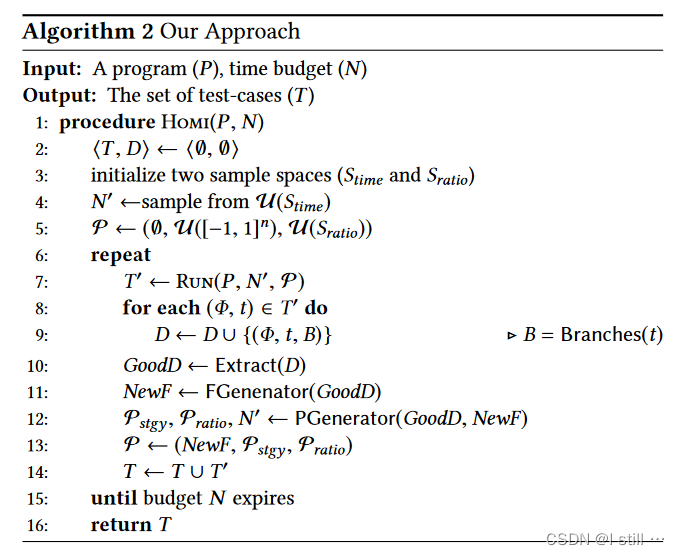
-
Homi的关键点,算法2,是通过符号执行期间的online learning,不断更新特征和两个概率分布, P s t g y P_{stgy} Pstgy 和 P r a t i o P_{ratio} Pratio。这一轮计算的概率数据 P s t g y P_{stgy} Pstgy 和 P r a t i o P_{ratio} Pratio 会在下一轮用来进行状态修剪。
-
在限定时间 N N N 内,标准符号执行只运行一次
RUN函数,而HOMI将 N N N 分成多个时间片(不是平均分),每次运行 N ′ N^{'} N′ 个时间单位。 -
μ \mu μ 是均匀分布。
在HOMI的运行过程中:
-
N ′ , P s t g y , P r a t i o N^{'}, P_{stgy}, P_{ratio} N′,Pstgy,Pratio 均采用均匀分布随机初始化, F F F 初始化为空集。因此第一轮
RUN,并不会进行状态修剪。 -
D D D 是由3元组 < Φ , t , B > <\Phi, t, B> <Φ,t,B> 构成的集合,第1个是路径条件,第2个是对应的测试用例,第3个是其覆盖的分支。
2.2.1.Collecting Promising Data
这一小节主要介绍算法2第10行 G o o d D ← E x t r a c t ( D ) GoodD \leftarrow Extract(D) GoodD←Extract(D) 的过程。 G o o d D GoodD GoodD 是 D D D 的一个子集,意味着最有意义的测试用例构成的集合,它们满足以下条件:
-
G o o d D GoodD GoodD 中所有用例的分支覆盖与 D D D 中相同。
-
G o o d D GoodD GoodD 最小化。
计算过程如下:
-
D ∗ = arg max D ′ ⊆ D ∣ ∪ B ∣ ( _ , _ , B ) ∈ D ′ D^* = \argmax\limits_{D^{'} \subseteq D} \mathop{| \cup B|}\limits_{ (\_,\_,B) \in D^{'}} D∗=D′⊆Dargmax(_,_,B)∈D′∣∪B∣,找出所有能让分支覆盖率最大化的集合。
-
G o o d D = arg min D ′ ∈ D ∣ D ′ ∣ GoodD = \argmin\limits_{D ^{'} \in D} |D^{'}| GoodD=D′∈Dargmin∣D′∣,选取最小的一个。
作者通过一个贪心算法实现上述过程。
2.2.2.Generating Features.
这部分对应算法2第11行 N e w F ← F G e n e r a t o r ( G o o d D ) NewF \leftarrow FGenerator(GoodD) NewF←FGenerator(GoodD),也就是将 G o o d D GoodD GoodD 中的所有状态转换成对应特征向量。
作者首先定义一个core branch condition的概念,core branch condition ϕ \phi ϕ 可由下面语言推导出
L : : = c o n d ∣ c o n d ⋀ c o n d ∣ c o n d ⋁ c o n d L ::= cond \; | \; cond \bigwedge cond \; | \; cond \bigvee cond L::=cond∣cond⋀cond∣cond⋁cond
c o n d : : = l v = n cond::= lv = n cond::=lv=n
l v : : = α ∣ α [ i ] lv::= \alpha \; | \; \alpha[i] lv::=α∣α[i]
l − v a l u e ( l v ) l-value (lv) l−value(lv) 表示一个符号值,或者符号数组的一个元素, c o n d cond cond 为判定符号值是否等于一个常量的表达式。core branch condition可以为单个表达式或多个表达式构成的合取范式或者析取范式。
为了生成特征向量作者
-
首先从 G o o d D GoodD GoodD 中提取所有的路径条件组成集合 P C PC PC, P C = { Φ ∣ ( Φ , _ , _ ) ∈ G o o d D } PC = \{\Phi \; | \; (\Phi, \_, \_) \in GoodD\} PC={Φ∣(Φ,_,_)∈GoodD}。
-
然后从 P C PC PC 中提取所有的条件表达式组成集合 N e w F NewF NewF, N e w F = { ϕ ∈ L ∣ ϕ ∈ Φ , Φ ∈ P C } NewF = \{\phi \in L \; | \; \phi \in \Phi, \Phi \in PC\} NewF={ϕ∈L∣ϕ∈Φ,Φ∈PC}, L L L 指前面能推导出core branch condition的语言。
假设有 P C = { { ( α = = 3 ) , ( α > 1 ) } , { ( α [ 2 ] , 3 ) , ( α [ 2 ] = = 8 ) } } PC = \{\{(\alpha == 3), (\alpha > 1)\}, \{(\alpha[2] , 3), (\alpha[2] == 8)\}\} PC={{(α==3),(α>1)},{(α[2],3),(α[2]==8)}},那么提取的 N e w F = { ( α = = 3 ) , ( α [ 2 ] = = 8 ) } NewF = \{(\alpha == 3), (\alpha[2] == 8)\} NewF={(α==3),(α[2]==8)}。
其中示例集合 N e w F NewF NewF 中的两个特征是确定每个路径条件的模型的最小条件;例如,第一路径条件的模型 α = = 3 ⋀ α > 1 \alpha == 3 \bigwedge \alpha > 1 α==3⋀α>1 可以简化成 α = = 3 \alpha == 3 α==3。简而言之,第11行生成的特征集 N e w F NewF NewF 代表了最小测试用例的关键证据,这些测试用例有助于最大化分支覆盖,直到当前状态。
可以看到,在循环的每一轮 N e w F NewF NewF 的维度都可能不一样,因此状态对应的特征向量在每一轮可能都维度不同。
2.2.3.Learning Distribution
在算法2第12行,
P
s
t
g
y
,
P
r
a
t
i
o
,
N
′
←
P
G
e
n
e
r
a
t
o
r
(
G
o
o
d
D
,
N
e
w
F
)
P_{stgy}, P_{ratio}, N^{'} \leftarrow PGenerator(GoodD, NewF)
Pstgy,Pratio,N′←PGenerator(GoodD,NewF) 中
P
G
e
n
e
r
a
t
o
r
PGenerator
PGenerator 会学习到向量
θ
\theta
θ 和标量
r
r
r 的概率分布
P
s
t
g
y
,
P
r
a
t
i
o
P_{stgy}, P_{ratio}
Pstgy,Pratio,输出的
N
′
N^{'}
N′ 会下个循环运行 RUN 的时间单位。
P s t g y = < P 1 , . . . , P n > P_{stgy} = <P_1, ..., P_n> Pstgy=<P1,...,Pn>, P i P_i Pi 为 N e w F NewF NewF 第i个特征对应的权重 θ i \theta^i θi 的概率。计算 P i P_i Pi:
-
首先从 G o o d D GoodD GoodD 中选取所有的testcase组成 G o o d T GoodT GoodT 集合, G o o d T = { t ∣ ( _ , t , _ ) ∈ G o o d D } GoodT = \{t \; | \;(\_,t,\_) \in GoodD\} GoodT={t∣(_,t,_)∈GoodD}。
-
其中算法会为每个testcase维护对应的四元组信息 t = ( F , θ , r , N ′ ) t = (F, \theta, r, N^{'}) t=(F,θ,r,N′)。
-
F F F 是testcase对应状态集合的特征向量集合,推测testcase遍历过的每个状态的特征向量都被提取了
-
θ \theta θ 是对应权重向量
-
r r r 是修剪比例
-
N ′ N^{'} N′ 是时间分配
-
-
收集所有状态的特征向量集合 G o o d F = ∪ ( F , _ , _ , _ ) ∈ G o o d T F GoodF = \mathop{\cup}\limits_{(F, \_, \_, \_) \in GoodT} F GoodF=(F,_,_,_)∈GoodT∪F
-
接着,按如下方式计算 P i P_i Pi,方便之后sample出 θ \theta θ:
-
P i = { N ( μ ( W i ) , δ ( W i ) , − 1 , 1 ) i f ( ϕ i n e w ∈ G o o d F ) u ( [ − 1 , 1 ] ) o t h e r w i s e P_i = \left\{ \begin{array}{rcl} \mathop{N}(\mu(W_i), \delta(W_i), -1, 1) & & {if (\phi_i^{new} \in GoodF)} \\ u([-1, 1]) & & {otherwise}\\ \end{array} \right. Pi={N(μ(Wi),δ(Wi),−1,1)u([−1,1])if(ϕinew∈GoodF)otherwise, ϕ i n e w \phi_i^{new} ϕinew 是 N e w F NewF NewF 中第i个条件, N \mathop{N} N表示截断正态分布,平均值 μ ( W i ) \mu(W_i) μ(Wi),标准差 δ ( W i ) \delta(W_i) δ(Wi),最大值1,最小值-1。 u u u 为均匀分布。
-
W i = { θ k ∣ ( ϕ i n e w = ϕ k ) ⋀ ( { ϕ 1 , . . . , ϕ n } , θ , _ , _ ) ∈ G o o d T } W_i = \{\theta^k \; | \; (\phi_i^{new} = \phi_k) \bigwedge (\{\phi_1, ..., \phi_n\}, \theta, \_, \_) \in GoodT\} Wi={θk∣(ϕinew=ϕk)⋀({ϕ1,...,ϕn},θ,_,_)∈GoodT},这个公式有点难以理解,假设目前 G o o d T GoodT GoodT 中有3个testcase,目前 ϕ i n e w \phi_i^{new} ϕinew 在这3个testcase中分别为路径条件上第1,2,3个core branch condition,在生成testcase时,这3个示例可能对应3个不同的向量 θ \theta θ(因为每次状态修剪都会重新sample一个 θ \theta θ),记为 θ 1 , θ 2 , θ 3 \theta_1, \theta_2, \theta_3 θ1,θ2,θ3。那么此时 W i = { θ 1 1 , θ 2 2 , θ 3 3 } W_i = \{\theta^1_1, \theta^2_2, \theta^3_3\} Wi={θ11,θ22,θ33}( θ j i \theta^i_j θji 表示向量 θ j \theta_j θj 第i维度的值)。
-
u ( W ) = ∑ w ∈ W w ∣ W ∣ u(W) = \sum\limits_{w \in W} \frac{w}{|W|} u(W)=w∈W∑∣W∣w, δ ( W ) = ∑ w ∈ W ( w − u ( W ) ) 2 ∣ W ∣ \delta(W) = \sqrt{\frac{\sum\limits_{w \in W}(w - u(W))^2}{|W|}} δ(W)=∣W∣w∈W∑(w−u(W))2
-
-
按上述步骤,可以求出 P s t g y P_{stgy} Pstgy 中每一项的概率分布,然后求 P r a t i o P_{ratio} Pratio 的分布:
P r a t i o ( X = r ′ ) = ∣ { ( _ , _ , r , _ ) ∈ G o o d T ∣ r ′ = r } ∣ ∣ G o o d T ∣ P_{ratio}(X = r^{'}) = \frac{|\{(\_, \_, r, \_) \in GoodT | r^{'} = r\}|}{|GoodT|} Pratio(X=r′)=∣GoodT∣∣{(_,_,r,_)∈GoodT∣r′=r}∣,这个概率分布会之后用来sample出 r r r -
再用同样的方式计算概率分布 P t i m e P_{time} Ptime,方便之后sample出 N ′ N^{'} N′
2.2.4.Sampling Values
这一步是基于 P s t g y P_{stgy} Pstgy 和 P r a t i o P_{ratio} Pratio sample出 θ \theta θ 和 r r r。生成 θ \theta θ 的方法采用下面3个方法之一:
-
Exploitation,从 P s t g y P_{stgy} Pstgy 中先sample出exploit向量: S a m p l e e x p l o i t ( P 1 × . . . × P n ) = < θ 1 , . . . , θ n > Sample_{exploit}(P_1 \times ... \times P_n) = <\theta^1, ..., \theta^n> Sampleexploit(P1×...×Pn)=<θ1,...,θn>
-
Reverse Exploitation, 逆向sample出向量 θ r \theta_r θr
-
U = { r 1 , r 2 , . . . , r 100 ∣ r i ∼ u ( − 1 , 1 ) } U = \{r_1, r_2, ..., r_{100} \; | \; r_i \sim u(-1, 1)\} U={r1,r2,...,r100∣ri∼u(−1,1)},用均匀分布sample出100维向量 U U U。
-
S a m p l e r e v e r s e ( P 1 × . . . × P n , U ) = < θ r 1 , . . . , θ r n > Sample_{reverse}(P_1 \times ... \times P_n, U) = <\theta_r^1, ..., \theta_r^n> Samplereverse(P1×...×Pn,U)=<θr1,...,θrn>, θ r i = arg max u ∈ U ( u − θ i ) \theta_r^i = \argmax\limits_{u \in U}(u - \theta^i) θri=u∈Uargmax(u−θi)
-
-
Exploration: 采用均匀分布采样的方法 u ( [ − 1 , 1 ] n ) u([-1, 1]^n) u([−1,1]n) sample出 θ \theta θ
最后从概率分布
P
r
a
t
i
o
P_{ratio}
Pratio 和
P
t
i
m
e
P_{time}
Ptime 中sample出
r
r
r 和下次运行 RUN 的时间
N
′
N^{'}
N′(
N
′
N^{'}
N′ 的值每次从 200, 400, 600, 800 中随机选择一个)。
2.2.5.总结
可以看出,HOMI的运行流程就是循环下面过程:
-
基于上一轮(第1轮不进行状态修剪)计算的概率数据 ( F , P s t g y , P r a t i o ) (F, P_{stgy}, P_{ratio}) (F,Pstgy,Pratio) 运行
RUN的时候进行状态修剪。-
P s t g y P_{stgy} Pstgy 用来sample出n维向量(n是 F F F 中core branch condition数量) θ \theta θ。
-
P r a t i o P_{ratio} Pratio 用来sample出修剪比例 r r r。
-
F F F 用来给每一个状态 s s s 计算特征向量 f e a t ( s ) feat(s) feat(s), f e a t ( s ) . θ feat(s).\theta feat(s).θ 即 s s s 的分数,选取分数最低的 k k k 个状态修剪掉。( k = ∣ S ∣ . r k = |S| . r k=∣S∣.r)
-
-
运行完毕后会产生testcase集合 T ′ T^{'} T′,从 T ′ T^{'} T′ 选出满足最小并且能达到和 T ′ T^{'} T′ 同样分支覆盖率的子集合 G o o d T ′ GoodT^{'} GoodT′。
-
从 G o o d T ′ GoodT^{'} GoodT′ 中提取core branch condition集合 F ′ F^{'} F′。
-
基于 F ′ , G o o d T ′ F^{'}, GoodT^{'} F′,GoodT′ 计算新的概率分布 P s t g y ′ , P r a t i o ′ P_{stgy}^{'}, P_{ratio}^{'} Pstgy′,Pratio′。
-
( F ′ , P s t g y ′ , P r a t i o ′ ) (F^{'}, P_{stgy}^{'}, P_{ratio}^{'}) (F′,Pstgy′,Pratio′) 会在下一轮用来进行状态修剪。
总的来说,作者的目标是找出一组能不断提高测试用例分支覆盖率的参数。
3.实验
探究的问题包括:
-
有效性:HOMI对提升分支覆盖率的效果如何?有多少bug只被HOMI发现了?
-
状态数量:与普通符号执行工具相比,HOMI在运行时维护多少状态?
-
与朴素方法的对比:与随机状态修剪相比,HOMI表现如何?
3.1.实验设置
使用了9个GNU开源程序,一些统计信息如下表所示:
| 程序名 | 总行数 | 分支数 |
|---|---|---|
| gawk-3.1.4 | 60904 | 11934 |
| grep-2.6 | 56931 | 7021 |
| combine-0.4.0 | 35756 | 2359 |
| grep-2.6 | 56931 | 7021 |
| ginstall (8.31) | 22290 | 3652 |
| ptx (8.31) | 22148 | 5262 |
| vdir (8.31) | 19378 | 3830 |
| pr (8.31) | 12156 | 1991 |
| dd (8.31) | 10531 | 1547 |
选用的baseline包括:
-
标准符号执行(不带状态修剪策略),分别采用9种不同的状态搜索策略:
-
CPICount (CallPath Instruction Count,
nurs:cpicnt) -
CovNew (
nurs:covnew) -
MinDistance (Minimal Distance to Uncovered,
nurs: md2u) -
InstrCount (Instruction Count,
nurs:icnt) -
QueryCost (
nurs:qc) -
RandomPath (
random-path) -
Depth (
nurs:depth) -
RandomState (
random-state) -
RoundRobin (klee默认)
-
其它设定包括(针对每个程序的运行)
-
运行参数:
--sym-args 0 1 10 --sym-args 0 2 2 --sym-files 1 8 --sym-stdin 8 --sym-stdout -
内存限制:2GB
-
时间限制:5小时
3.2.有效性
下图反映了HOMI+covnew与标准符号执行+5个策略的对比结果
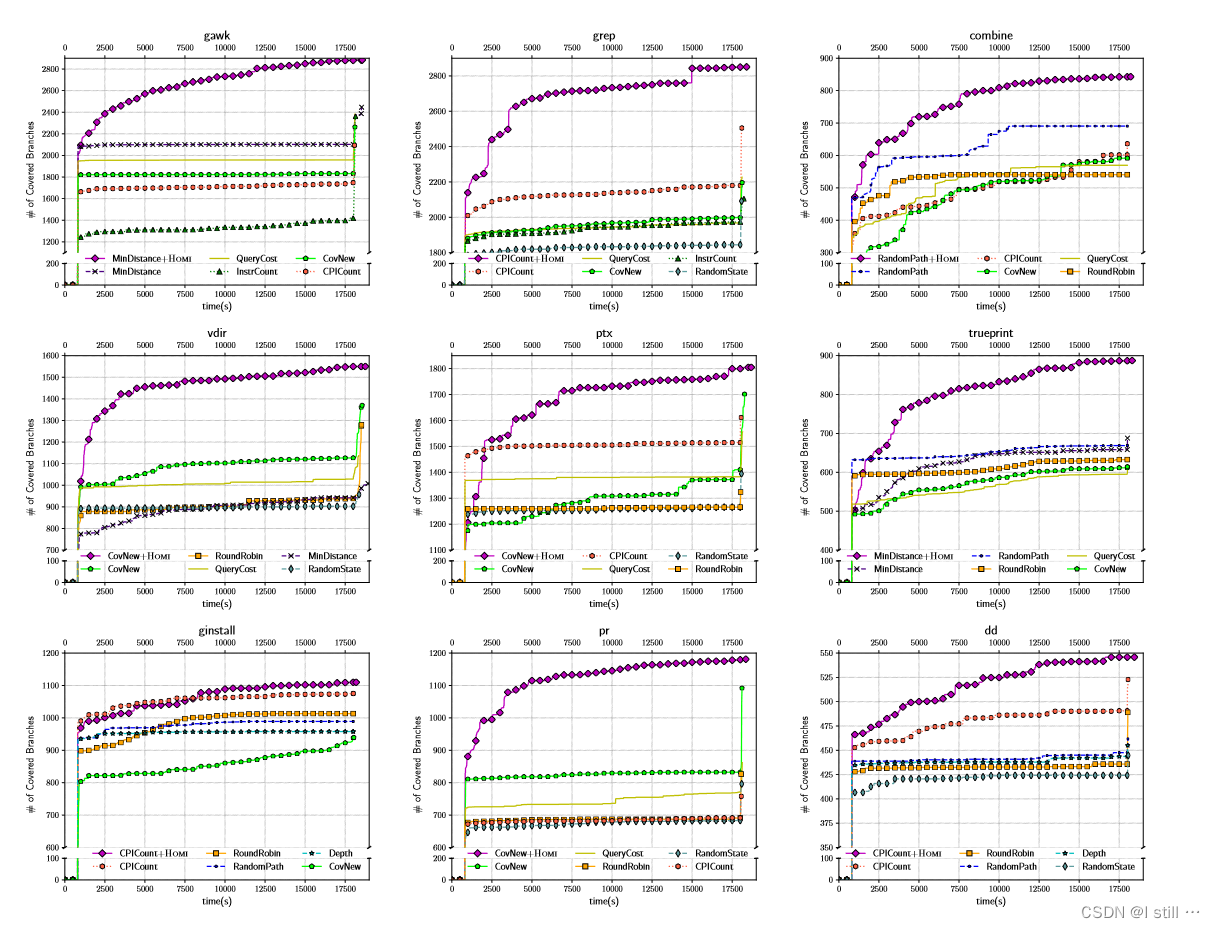
下表展示了仅由HOMI结合表现最佳的搜索策略(BestH)以及标准符号执行结合排名前5的搜索策略(xthH)覆盖到的分支的数量。
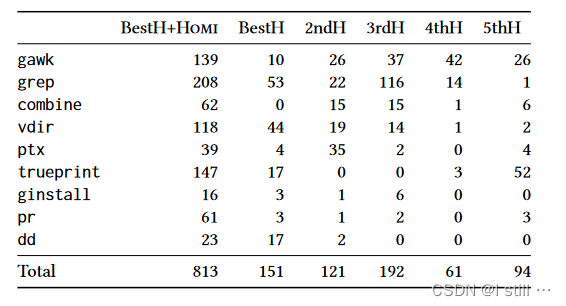
下表展示了表现最好的2种搜索策略结合与不结合HOMI的bug查找能力的对比

3.3.候选状态数量
下表展示了不同策略每一时刻状态列表的长度,紫线为MinDistance+HOMI,其它为标准符号执行结合不同搜索策略。
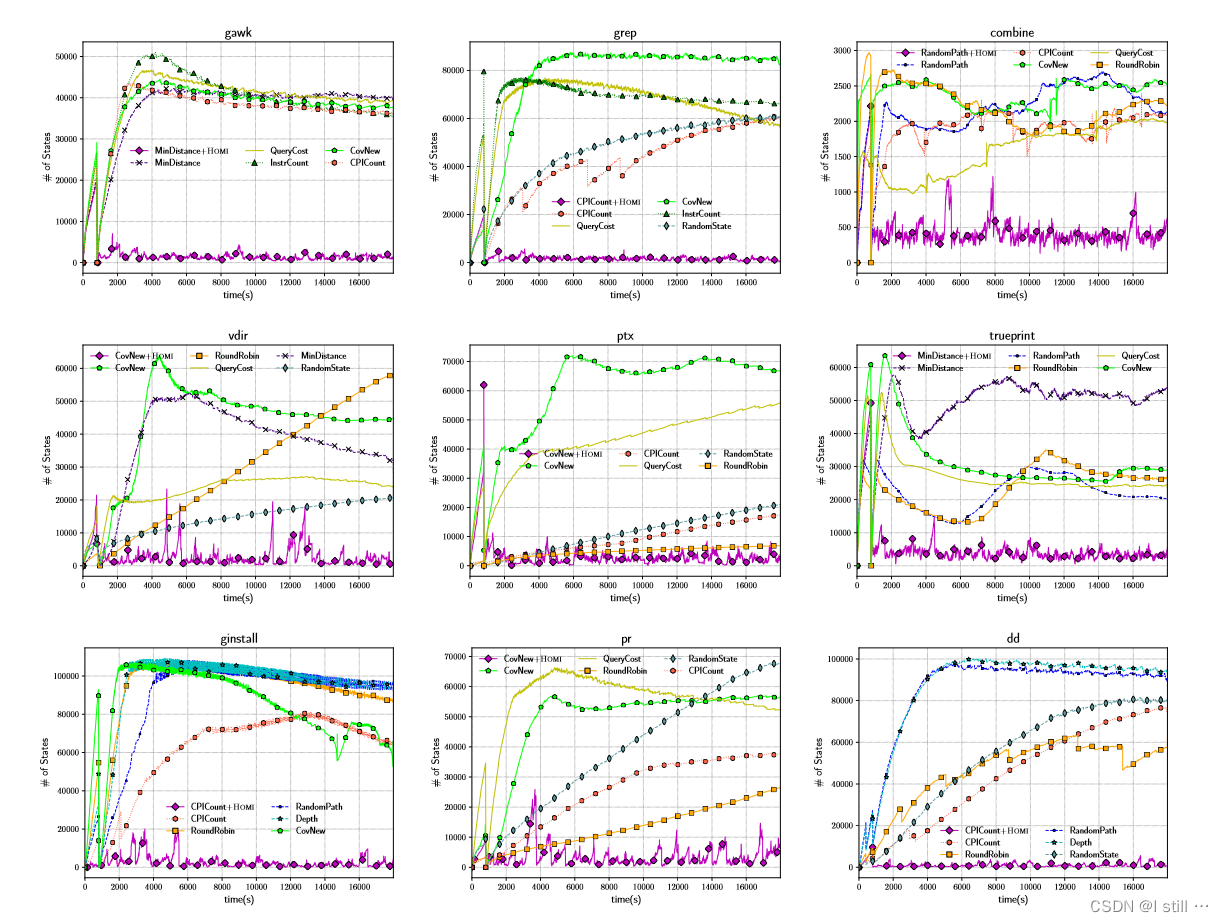
3.4.与朴素方法的对比
下表反映了HOMI+CPICNT与Random+CPICNT(随机状态修剪),CPICNT,CPICNT(divide)的对比
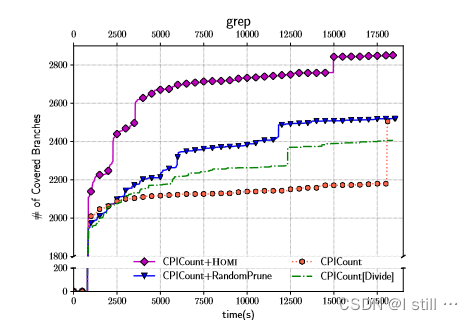
4.代码实操
Homi的github地址,作者提供了一个20G的vdi虚拟硬盘,用virtualbox打开,可以省去配环境的麻烦,并且里面klee和benchmark已经编译好了。作者的环境为:
-
klee-2.0
-
LLVM 6.0.0
整个Homi的文件夹组织为:
-
script: python脚本都存放在这个目录下 -
klee: 作者修改后的klee项目目录 -
experiments: 存放实验中间文件和各种输出文件的目录 -
benchmarks: 存放各种数据集
代码实操主要以 trueprint 这个程序为示例介绍,作者给出运行的命令如下:
-
cd ~/Homi/script -
python3 Homi.py pgm_config/1trueprint.json 3600 homi nurs:md2u 1pgm_config/1trueprint.json包含各种文件路径,内容如下(当前路径为~/Homi/script):
{ "pgm_name": "trueprint", # 程序名 "pgm_dir": "../benchmarks/trueprint-5.4/obj-llvm/", # llvm编译路径 "exec_dir": "/src", # 可执行文件的子路径 "gcov_path": "../benchmarks/trueprint-5.4/1obj-gcov/src/", # gcov存放路径 "gcov_file": "../*/*.gcov", # gcov文件路径模式 "gcda_file": "../*/*.gcda" # gcda文件路径模式 }-
3600为符号执行该程序的时间限制,单位秒。 -
homi表示运行homi,与之对应的参数是klee,表示运行普通符号执行。 -
nurs:md2u表示选择的搜索策略。 -
1表示实验次数,主要是用来构建中间文件名称用,其它并没有什么实际作用。
Homi.py 的 main 函数核心部分如下:
if tool=="homi":
# Homi performs the general symbolic execution without state-pruning on the first iteration.
Run_KLEE(pgm_config, pgm, stgy, total_time, small_time, ith_trial, iters, tool, d_name, Space_time)
while iters<100:
dir_name, Data = Run_gcov(load_config, pgm, stgy, iters, tool, ith_trial, Data, d_name)
topk_testcases = SetCoverProblem(Data, iters)
features = Feature_Extractor(pgm, stgy, dir_name, topk_testcases, ith_trial, iters)
small_time= PruningStgy_Generator(load_config, pgm, stgy, ith_trial, features, dir_name, topk_testcases, iters, Space_time)
iters=iters+1
Run_KLEE(pgm_config, pgm, stgy, total_time, small_time, ith_trial, iters, tool, d_name, Space_time)
else:
for num in range(1,100):
Run_KLEE(pgm_config, pgm, stgy, total_time, small_time, ith_trial, iters, tool, d_name, Space_time)
iters=iters+1
-
Run_KLEE 对应paper算法2中第7行的
RUN函数,不过代码里作者换了1种写法,在while循环外先RUN一次,然后循环体内第1句到倒数第2句都是收集 ( F ′ , P s t g y ′ , P r a t i o ′ ) (F^{'}, P_{stgy}^{'}, P_{ratio}^{'}) (F′,Pstgy′,Pratio′) 为下一次状态修剪做准备。 -
Run_gcov 对应算法2 8-9行 D D D 的收集过程。
-
SetCoverProblem 对应算法2 第10行 G o o d D ← E x t r a c t ( D ) GoodD \leftarrow Extract(D) GoodD←Extract(D)。算法输出的是一个
list,每个元素是一个testcase名称,str类型,诸如x_tc_dir/test000001.ktest形式。 -
Feature_Extractor 对应算法2 第11行 N e w F ← F G e n e r a t o r ( G o o d D ) NewF \leftarrow FGenerator(GoodD) NewF←FGenerator(GoodD)。
-
PruningStgy_Generator 对应算法2 第12行 P s t g y , P r a t i o , N ′ ← P G e n e r a t o r ( G o o d D , N e w F ) P_{stgy}, P_{ratio}, N^{'} \leftarrow PGenerator(GoodD, NewF) Pstgy,Pratio,N′←PGenerator(GoodD,NewF)。
在参数和返回值方面:
-
dir_name为中间文件夹路径,在该示例中为result_All/{x}homi_trueprint_nurs:md2u_tc_dir,{x}表示实验轮次。dir_name为~/Homi/experiments下的相对路径,用来存放各种输出文件。 -
Space_time为硬编码的参数,为[200, 400, 600, 800] -
small_time对应paper中的 N ′ N^{'} N′,初始为800。 -
Data为Dict[str, Set[int]]类型,对应paper中的 D D D。-
key为testcase的相对路径,比如
test000001.ktest对应的key为x_tc_dir/test000001.ktest,x为循环次数,如果这次是第1次运行Run_gcov那就是1_tc_dir/test000001.ktest,value为该testcase覆盖的branch行数。 -
在paper中, D D D 为一个
set,元素为 ( ϕ , t , B ) (\phi, t, B) (ϕ,t,B)(路径条件,测试用例,覆盖的branch)
-
-
topk_testcases为List[str],对应 G o o d D GoodD GoodD,不过只保存了名字。 -
features对应 F ′ F^{'} F′。
4.1.代码运行
命令行运行 python3 Homi.py pgm_config/1trueprint.json 3600 homi nurs:md2u 1,运行结束后 experiments 下的目录结构如下:
../experiments
├── homi__nurs:md2u0
│ └── trueprint
├── homi__nurs:md2u1
│ └── trueprint
├── homi__nurs:md2u2
│ └── trueprint
├── homi__nurs:md2u3
│ └── trueprint
├── homi__nurs:md2u4
│ └── trueprint
├── homi__nurs:md2u5
│ └── trueprint
├── homi__nurs:md2u6
│ └── trueprint
└── result_All
└── 1homi_trueprint_nurs:md2u_tc_dir
├── 0__tc_dirs
├── 1__tc_dirs
├── 2__tc_dirs
├── 3__tc_dirs
├── 4__tc_dirs
├── 5__tc_dirs
├── 6__tc_dirs
其中
-
从文件夹数量来看,循环进行了7次(
Feature_Generator)运行了7次。 -
homi__nurs:md2u{i}/trueprint为空目录,这个目录主要是创建来把benchmark编译后的文件复制进来,每次运行Run_KLEE的时候都会生成一个homi__nurs:md2u{i}/trueprint目录并把benchmark复制进来,符号执行便在homi__nurs:md2u{i}/trueprint目录下进行,{i}指第i次循环,执行完后会执行cp -r klee-out-0 Homi/experiments/result_All/1homi_trueprint_nurs:md2u_tc_dir/{i}__tc_dirs将生成的testcase等文件复制到result_All文件夹下并清空homi__nurs:md2u{i}/trueprint目录。 -
result_All/1homi_trueprint_nurs:md2u_tc_dir下有1个1homi_trueprint_nurs:md2u_pruning_ratio文件,表示最新一轮PruningStgy_Generator后sample出的 r r r 值,但是里面保存了50个值,在运行1次 R U N RUN RUN 时会进行多次状态修剪,每次修剪都会用到不同的 r r r 值。在原paper算法1中, r r r 理论上每次执行 P r u n e Prune Prune 的时候sample出1个。 -
result_All/1homi_trueprint_nurs:md2u_tc_dir/weights/{i}trial下保存了 50 个w文件,每一个对应1个 θ \theta θ 向量,每次进行状态修剪会用到不同的 θ \theta θ 向量。在原paper算法1中, θ \theta θ 理论上每次执行 P r u n e Prune Prune 的时候sample出1个。 -
result_All/1homi_trueprint_nurs:md2u_tc_dir下有1个1homi_trueprint_nurs:md2u_feature_data文件,保存的应该是最新一轮Feature_Extractor之后生成的特征集合 F ′ F^{'} F′,内容放在最下面了,每一行对应一个core branch condition,str类型。 -
result_All/1homi_trueprint_nurs:md2u_tc_dir/weights下有7个feature_data文件,对应每一轮Feature_Extractor生成的特征集合。
4.2.Run_KLEE
python脚本部分参考 Homi.py – Run_KLEE ,Run_KLEE.py,其中 gen_run_cmd 函数拼凑出运行klee的命令,在示例中为: Homi/klee/build/bin/klee -trial=0 --max-memory=2000 --watchdog -max-time=800 -dirname=~/Homi/experiments/result_All -write-kqueries -only-output-states-covering-new --simplify-sym-indices --output-module=false --output-source=false --output-stats=false --disable-inlining --use-forked-solver --use-cex-cache --libc=uclibc --posix-runtime -env-file=~/Homi/klee/build/../test.env --max-sym-array-size=4096 --max-instruction-time=30 --switch-type=internal --use-batching-search --batch-instructions=10000 -ignore-solver-failures --search=nurs:md2u trueprint.bc --sym-args 0 1 10 --sym-args 0 2 2 --sym-files 1 8 --sym-stdin 8 --sym-stdout
接下来看 Executor.cpp run函数,首先读取上一轮计算好的 F ′ F^{'} F′ 和 P r a t i o P_{ratio} Pratio。
if(Homi){
Generate a set of features.
feat_id_map_=read_feature(dirname, naming);
pratio_vec_=read_pruningratio(dirname, naming);
}
-
feat_id_map_对应 F ′ F^{'} F′,是一个map<string, unsigned int>,key为core branch condition对应的字符串,value为该condition在特征集合中的索引好,最下面的feature_data文件对应的feat_id_map_为{"(Eq 46 (Read w8 1 arg02))": 0, "(Eq 49 (Extract w8 0 (SExt w32 (Read w8 1 arg01))))": 1, ...} -
pratio_vec_是一个vector<unsigned>, 长度为50。前面说过,代码中为了方便不是严格意义上在 R U N RUN RUN 中用 P r a t i o P_{ratio} Pratio 采样,而是先采样50个 r r r 值,然后修剪状态时轮着用,因此pratio_vec_对应50个不同的 r r r 值。
同时在代码中
-
每秒(
prev_time变量就是为了这个)都会采样当前状态列表长度,打印到state_data文件中,并且运行的时候每30秒并且状态列表长度大于500时才进行修剪,而不是像paper 算法1中每次选择状态之前都修剪。 -
修剪状态时,先从
weights/{i}trials文件夹下读取w文件中的 θ \theta θ 向量(对应变量wvector_,vector<double>类型),而不是读取 P s t g y P_{stgy} Pstgy 再采样,同样的,执行klee时已经从 P s t g y P_{stgy} Pstgy 时采样了50个 θ \theta θ 向量轮着用。 -
fv_vecs = extract_feature(states, feat_id_map_);根据 θ \theta θ 和计算每个状态的特征向量,fv_vecs为vector<vector<int>>类型,一般第1维是状态数量,第2维是特征长度。-
extract_feature 对应paper中计算 f e a t ( s ) feat(s) feat(s) 的部分,如果
feat_id_map_第i个condition出现在状态s的路径约束中,那么 f e a t i ( s ) = 1 feat_i(s) = 1 feati(s)=1,反之为 0 0 0。 -
extract_feature 最后一行会记录一个冗余特征索引,如果1个特征对所有得状态都是0或1,那这个特征是冗余特征。因此
fv_vecs的最后1个向量记录的是冗余特征索引。
-
-
prune_states(wv_name, fv_vecs, wvector_, pruning_ratio);进行状态修剪。-
prune_states 返回值是被修剪得状态数量,如果有效特征维度(core branch condition)数量太小(特征数-冗余特征数 <= 5)那就不进行状态修剪。
-
修剪状态的方式就是调用
terminateStateEarly,对于terminateStateEarly生成的testcase,klee会输出一个.early文件,里面记录message,被修剪状态的message是learning_data字符串,里面记录了冗余特征索引、修剪比率 r r r、采用的向量 θ \theta θ。
-
剩下就是正常进行符号执行。
4.3.Run_Gcov
这一部分对应算法2 8-9行
D
D
D 的收集过程,返回值 Data 为 Dict[str, Set[int]] 型,key为testcase文件名,value为该testcase独自覆盖到的分支(分支用gcov文件行号标识,最下面有gcov文件示例)。
-
首先,Run_Gcov 会计算一个
d_tc_data变量,该变量为dict,将每个testcase文件路径映射为一个四元组[budget, pratio, l_rfeats, wvector],即该testcase生成时klee运行时间限制( N ′ N^{'} N′)、修剪比率 r r r,冗余特征索引、向量 θ \theta θ 存储的文件路径。 -
然后,Run_Gcov对每个testcase:
-
运行klee-replay。生成gcda文件。
-
运行gcov -b xxx.gcda,生成对应gcov文件。
-
解析gcov文件,找出该testcase覆盖到的分支,具体过程可参考CalCoverage。6.3部分给出了一个gcov示例,在gcov文件中,
branch开头的行代表一条分支,never表示对应条件判断语句没被执行过,taken 0%表示条件语句执行过但是没覆盖过该分支。在计算分支覆盖率时用gcov文件行号来标识一个分支。 -
将该testcase覆盖情况写入变量
Data。
-
运行完 Run_Gcov 后接下来会通过 SetCoverProblem 生成
G
o
o
d
D
GoodD
GoodD,返回值 topk_testcases 为 List[str] 型,记录
G
o
o
d
D
GoodD
GoodD 每一个testcase对应的文件路径。
4.4.Feature_Extractor
在运行klee时,作者添加了 -write-kqueries 参数,因此每个testcase都会生成一个对应的 kquery 文件,保存对应的路径约束。这篇blog最底部有个 kquery 文件示例。
Feature_Extractor 则是通过遍历一个testcase的 kquery 文件生成
F
′
F^{'}
F′(
F
′
F^{'}
F′ 对应代码中的 feat_set,为 Set[str] 类型),每一个core branch condition应该为 Eq ... arg ... 这样的 str。一次最多提取200个core branch condition。
最后,将 feat_set dump到一个 {i}homi_trueprint_nurs:md2u_feature_data 文件中(i 为实验轮次),这个文件每轮循环都会被覆盖。
4.5.PruningStgy_Generator
相当于
P
G
e
n
e
r
a
t
o
r
(
G
o
o
d
D
,
N
e
w
F
)
PGenerator(GoodD, NewF)
PGenerator(GoodD,NewF)。这部分用到了一个全局变量 tried_wv,该变量将.w文件路径映射为该文件中的向量
θ
\theta
θ。
在paper中,作者提到了3种 ( P s t g y , P r a t i o ) (P_{stgy}, P_{ratio}) (Pstgy,Pratio) 生成方案:exploit, reverse_exploit, explore。其中explore几乎等同于随机概率选择,并没有用到之前计算的特征值。对于生成方案的选择,作者选用以下策略:
-
如果循环次数在10次以内,那么选择explore方案。
-
其它情况从3种方案种随机选择一种方案。
对于explore方案,其
θ
\theta
θ 生成代码对应333行 weights = [str(random.uniform(lower, upper)) for _ in range(len(features))] ,即
θ
\theta
θ 每一维度都是在 -1, 1之间均匀随机选择。
对于剩下2种方案,首先根据 Run_Gcov 生成的 d_tc_data 计算变量 d_feat_wvs,该变量对应paper中3.2.3的
W
W
W,将没有成为冗余特征的core branch condition(str 类型,比如 (Eq 46 (Read w8 1 arg02)))映射为在
G
o
o
d
D
GoodD
GoodD 中出现过的所有权重。对于core branch condition
i
i
i(即特征集合第
i
i
i 个特征),d_feat_wvs[i] 对应
W
i
W_i
Wi。剩下的代码则是按照论文所说的方法直接sample出50个
θ
\theta
θ 向量。
5.参考文献
Cha S , Oh H . Making symbolic execution promising by learning aggressive state-pruning strategy[C]// ESEC/FSE '20: 28th ACM Joint European Software Engineering Conference and Symposium on the Foundations of Software Engineering. ACM, 2020.
6.其它示例
6.1.kquery
代码
#include <klee/klee.h>
int main() {
int a, b, c, res;
klee_make_symbolic(&a, sizeof(a), "a");
klee_make_symbolic(&b, sizeof(b), "b");
klee_make_symbolic(&c, sizeof(c), "c");
if (a <= 0)
a = a + 10;
else
a = a - 10;
if (a <= b)
res = a - b;
else
res = a + b;
if (res > c)
res = 1;
else
res = 0;
return 0;
}
kquery:
对应 false --> false --> true 分支的kquery文件内容如下,前3行为输入变量,下面则是kquery语句()
array a[4] : w32 -> w8 = symbolic
array b[4] : w32 -> w8 = symbolic
array c[4] : w32 -> w8 = symbolic
(query [
(Eq false (Sle N0:(ReadLSB w32 0 a) 0))
(Eq false (Sle (Add w32 4294967286 N0) N1:(ReadLSB w32 0 b)))
(Slt (ReadLSB w32 0 c) (Add w32 4294967286 (Add w32 N0 N1)))
] false)
6.2.feature_data内容
(Eq 46 (Read w8 1 arg02))
(Eq 49 (Extract w8 0 (SExt w32 (Read w8 1 arg01))))
(Eq 43 (Read w8 8 arg00))
(Eq 43 (Read w8 7 arg00))
(Eq 52 (Extract w8 0 (SExt w32 (Read w8 1 arg01))))
(Eq 90 (Extract w8 0 (SExt w32 (Read w8 1 arg01))))
(Eq 67 (Extract w8 0 (SExt w32 (Read w8 2 arg00))))
(Eq 46 (Read w8 2 arg00))
(Eq 1 (Read w8 4 arg00))
(Eq 116 (Extract w8 0 (SExt w32 (Read w8 1 arg01))))
(Eq 0 (Read w8 2 arg00))
(Eq 0 (Read w8 7 arg00))
(Eq 101 (Read w8 3 arg00))
(Eq 118 (Read w8 9 arg00))
(Eq 64 (Read w8 6 arg00))
(Eq 97 (Read w8 8 arg00))
(Eq 64 (Read w8 7 arg00))
(Eq 111 (Read w8 7 arg00))
(Eq 103 (Read w8 6 arg00))
(Eq 61 (Read w8 9 arg00))
(Eq 114 (Extract w8 0 (SExt w32 (Read w8 1 arg02))))
(Eq 120 (Read w8 8 arg00))
(Eq 46 (Read w8 3 arg00))
(Eq 1 (Read w8 0 arg02))
(Eq 112 (Read w8 8 arg00))
(Eq 0 (Read w8 1 arg01))
(Eq 105 (Read w8 7 arg00))
(Eq 100 (Read w8 5 arg00))
(Eq 72 (Read w8 9 arg00))
(Eq 45 (Read w8 0 arg00))
(Eq 100 (Read w8 9 arg00))
(Eq 72 (Read w8 7 arg00))
(Eq 108 (Read w8 2 arg00))
(Eq 107 (Read w8 8 arg00))
(Eq 45 (Read w8 0 arg01))
(Eq 115 (Read w8 9 arg00))
(Eq 0 (Read w8 1 arg02))
(Eq 32 (Read w8 2 arg00))
(Eq 52 (Extract w8 0 (SExt w32 (Read w8 1 arg02))))
(Eq 74 (Extract w8 0 (SExt w32 (Read w8 3 arg00))))
(Eq 111 (Extract w8 0 (SExt w32 (Read w8 1 arg00))))
(Eq 109 (Read w8 7 arg00))
(Eq 76 (Extract w8 0 (SExt w32 (Read w8 1 arg01))))
(Eq 117 (Read w8 5 arg00))
(Eq 46 (Read w8 8 arg00))
(Eq 104 (Read w8 8 arg00))
(Eq 115 (Read w8 6 arg00))
(Eq 111 (Read w8 3 arg00))
(Eq 76 (Extract w8 0 (SExt w32 (Read w8 1 arg00))))
(Eq 104 (Read w8 1 arg02))
(Eq 117 (Read w8 4 arg00))
(Eq 115 (Extract w8 0 (SExt w32 (Read w8 1 arg01))))
(Eq 119 (Extract w8 0 (SExt w32 (Read w8 1 arg01))))
(Eq 120 (Read w8 9 arg00))
(Eq 0 (Read w8 5 arg00))
(Eq 99 (Read w8 9 arg00))
(Eq 114 (Read w8 7 arg00))
(Eq 51 (Extract w8 0 (SExt w32 (Read w8 1 arg01))))
(Eq 1 (Read w8 2 arg00))
(Eq 109 (Extract w8 0 (SExt w32 (Read w8 1 arg00))))
(Eq 100 (Read w8 2 arg00))
(Eq 117 (Read w8 6 arg00))
(Eq 108 (Read w8 4 arg00))
(Eq 104 (Read w8 7 arg00))
(Eq 64 (Read w8 9 arg00))
(Eq 45 (Read w8 9 arg00))
(Eq 0 (Read w8 4 arg00))
(Eq 66 (Extract w8 0 (SExt w32 (Read w8 1 arg01))))
(Eq 0 (Read w8 9 arg00))
(Eq 84 (Extract w8 0 (SExt w32 (Read w8 1 arg01))))
(Eq 116 (Extract w8 0 (SExt w32 (Read w8 1 arg00))))
(Eq 0 (Read w8 3 arg00))
(Eq 89 (Extract w8 0 (SExt w32 (Read w8 4 arg00))))
(Eq 103 (Read w8 8 arg00))
(Eq 61 (Read w8 8 arg00))
(Eq 45 (Read w8 1 arg00))
(Eq 87 (Extract w8 0 (SExt w32 (Read w8 2 arg00))))
(Eq 99 (Read w8 2 arg00))
(Eq 100 (Read w8 7 arg00))
(Eq 111 (Read w8 8 arg00))
(Eq 117 (Extract w8 0 (SExt w32 (Read w8 2 arg00))))
(Eq 46 (Read w8 0 arg00))
(Eq 32 (Read w8 5 arg00))
(Eq 43 (Read w8 3 arg00))
(Eq 118 (Read w8 0 arg02))
(Eq 61 (Read w8 4 arg00))
(Eq 98 (Extract w8 0 (SExt w32 (Read w8 1 arg00))))
(Eq 102 (Read w8 7 arg00))
(Eq 103 (Read w8 5 arg00))
(Eq 108 (Read w8 7 arg00))
(Eq 110 (Extract w8 0 (SExt w32 (Read w8 4 arg00))))
(Eq 106 (Read w8 7 arg00))
(Eq 1 (Read w8 0 arg00))
(Eq 45 (Read w8 0 arg02))
(Eq 46 (Read w8 4 arg00))
(Eq 97 (Read w8 7 arg00))
(Eq 51 (Extract w8 0 (SExt w32 (Read w8 1 arg02))))
(Eq 99 (Read w8 8 arg00))
(Eq 114 (Extract w8 0 (SExt w32 (Read w8 1 arg01))))
(Eq 98 (Read w8 5 arg00))
(Eq 101 (Read w8 8 arg00))
(Eq 116 (Read w8 6 arg00))
(Eq 88 (Extract w8 0 (SExt w32 (Read w8 3 arg00))))
(Eq 103 (Extract w8 0 (SExt w32 (Read w8 1 arg01))))
(Eq 119 (Read w8 7 arg00))
(Eq 108 (Read w8 6 arg00))
(Eq 37 (Read w8 6 arg00))
(Eq 46 (Read w8 7 arg00))
(Eq 120 (Read w8 4 arg00))
(Eq 101 (Read w8 9 arg00))
(Eq 101 (Read w8 7 arg00))
(Eq 68 (Read w8 7 arg00))
(Eq 45 (Read w8 8 arg00))
(Eq 109 (Read w8 9 arg00))
(Eq 50 (Extract w8 0 (SExt w32 (Read w8 1 arg02))))
(Eq 112 (Read w8 9 arg00))
(Eq 87 (Extract w8 0 (SExt w32 (Read w8 1 arg00))))
(Eq 112 (Read w8 6 arg00))
(Eq 99 (Read w8 7 arg00))
(Eq 106 (Read w8 6 arg00))
(Eq 72 (Extract w8 0 (SExt w32 (Read w8 1 arg01))))
(Eq 68 (Extract w8 0 (SExt w32 (Read w8 1 arg00))))
(Eq 104 (Read w8 9 arg00))
(Eq 97 (Read w8 9 arg00))
(Eq 46 (Read w8 5 arg00))
(Eq 45 (Read w8 7 arg00))
(Eq 67 (Read w8 7 arg00))
(Eq 61 (Read w8 5 arg00))
(Eq 84 (Read w8 7 arg00))
(Eq 115 (Read w8 8 arg00))
(Eq 115 (Read w8 0 arg02))
(Eq 71 (Extract w8 0 (SExt w32 (Read w8 1 arg00))))
(Eq 37 (Read w8 7 arg00))
(Eq 120 (Read w8 3 arg00))
(Eq 111 (Extract w8 0 (SExt w32 (Read w8 1 arg01))))
(Eq 46 (Read w8 6 arg00))
(Eq 97 (Read w8 3 arg00))
(Eq 118 (Read w8 8 arg00))
(Eq 108 (Read w8 9 arg00))
(Eq 98 (Extract w8 0 (SExt w32 (Read w8 3 arg00))))
(Eq 37 (Read w8 9 arg00))
(Eq 47 (Read w8 4 arg00))
(Eq 46 (Read w8 1 arg00))
(Eq 46 (Read w8 1 arg01))
(Eq 115 (Read w8 5 arg00))
(Eq 112 (Read w8 7 arg00))
(Eq 46 (Read w8 0 arg01))
(Eq 110 (Read w8 4 arg00))
(Eq 97 (Read w8 4 arg00))
(Eq 98 (Read w8 4 arg00))
(Eq 120 (Extract w8 0 (SExt w32 (Read w8 1 arg01))))
(Eq 50 (Extract w8 0 (SExt w32 (Read w8 1 arg01))))
(Eq 49 (Extract w8 0 (SExt w32 (Read w8 1 arg02))))
(Eq 67 (Read w8 9 arg00))
gcov示例
用 gcov -b 生成对应的gcov文件。
80: 315: if (n == (size_t) -2)
branch 0 taken 0% (fallthrough)
branch 1 taken 100%
-: 316: {
-: 317:# if SUPPORT_OLD_MBRTOWC
#####: 318: state = backup_state;
-: 319:# endif
#####: 320: break;
-: 321: }
80: 322: if (n == (size_t) -1)
branch 0 taken 0% (fallthrough)
branch 1 taken 100%
-: 323: {
-: 324: /* Remember that we read a byte, but don't complain
-: 325: about the error. Because of the decoding error,
-: 326: this is a considered to be byte but not a
-: 327: character (that is, chars is not incremented). */
#####: 328: p++;
#####: 329: bytes_read--;
-: 330: }
-: 331: else
-: 332: {
80: 333: if (n == 0)
branch 0 taken 1% (fallthrough)
branch 1 taken 99%
-: 334: {
1: 335: wide_char = 0;
1: 336: n = 1;
-: 337: }
80: 338: p += n;
80: 339: bytes_read -= n;
80: 340: chars++;
80: 341: switch (wide_char)
branch 0 taken 1%
branch 1 taken 0%
branch 2 taken 1%
branch 3 taken 95%
branch 4 taken 0%
branch 5 taken 3%
-: 342: {
1: 343: case '\n':
1: 344: lines++;
-: 345: /* Fall through. */
1: 346: case '\r':
-: 347: case '\f':
1: 348: if (linepos > linelength)
branch 0 taken 0% (fallthrough)
branch 1 taken 100%
#####: 349: linelength = linepos;
1: 350: linepos = 0;
1: 351: goto mb_word_separator;
1: 352: case '\t':
1: 353: linepos += 8 - (linepos % 8);
1: 354: goto mb_word_separator;
76: 355: case ' ':
76: 356: linepos++;
-: 357: /* Fall through. */
-: 358: case '\v':
78: 359: mb_word_separator:
78: 360: words += in_word;
78: 361: in_word = false;
78: 362: break;
2: 363: default:
2: 364: if (iswprint (wide_char))
branch 0 taken 50% (fallthrough)
branch 1 taken 50%
-: 365: {
1: 366: int width = wcwidth (wide_char);
call 0 returned 100%
1: 367: if (width > 0)
branch 0 taken 100% (fallthrough)
branch 1 taken 0%
1: 368: linepos += width;
1: 369: if (iswspace (wide_char))
branch 0 taken 0% (fallthrough)
branch 1 taken 100%
#####: 370: goto mb_word_separator;
1: 371: in_word = true;
-: 372: }
2: 373: break;
-: 374: }
-: 375: }
-: 376: }
80: 377: while (bytes_read > 0);
branch 0 taken 88%
branch 1 taken 13% (fallthrough)
-: 378:
-: 379:# if SUPPORT_OLD_MBRTOWC
10: 380: if (bytes_read > 0)
branch 0 taken 0% (fallthrough)
branch 1 taken 100%
-: 381: {
#####: 382: if (bytes_read == BUFFER_SIZE)
branch 0 never executed
branch 1 never executed
-: 383: {
-: 384: /* Encountered a very long redundant shift sequence. */
#####: 385: p++;
#####: 386: bytes_read--;
-: 387: }
#####: 388: memmove (buf, p, bytes_read);
-: 389: }
10: 390: prev = bytes_read;
-: 391:# endif
-: 392: }
12: 393: if (linepos > linelength)
branch 0 taken 83% (fallthrough)
branch 1 taken 17%
10: 394: linelength = linepos;
12: 395: words += in_word;
-: 396: }
-: 397:#endif
-: 398: else
-: 399: {
#####: 400: bool in_word = false;
#####: 401: uintmax_t linepos = 0;
-: 402:
#####: 403: while ((bytes_read = safe_read (fd, buf, BUFFER_SIZE)) > 0)
call 0 never executed
branch 1 never executed
branch 2 never executed
-: 404: {
#####: 405: const char *p = buf;
#####: 406: if (bytes_read == SAFE_READ_ERROR)
branch 0 never executed
branch 1 never executed
-: 407: {
#####: 408: error (0, errno, "%s", file);
call 0 never executed
#####: 409: ok = false;
#####: 410: break;
-: 411: }
-: 412:
#####: 413: bytes += bytes_read;
-: 414: do
-: 415: {
#####: 416: switch (*p++)
branch 0 never executed
branch 1 never executed
branch 2 never executed
branch 3 never executed
branch 4 never executed
branch 5 never executed
-: 417: {
#####: 418: case '\n':
#####: 419: lines++;
-: 420: /* Fall through. */
#####: 421: case '\r':
-: 422: case '\f':
#####: 423: if (linepos > linelength)
branch 0 never executed
branch 1 never executed
#####: 424: linelength = linepos;
#####: 425: linepos = 0;
#####: 426: goto word_separator;
#####: 427: case '\t':
#####: 428: linepos += 8 - (linepos % 8);
#####: 429: goto word_separator;
#####: 430: case ' ':
#####: 431: linepos++;
-: 432: /* Fall through. */
-: 433: case '\v':
#####: 434: word_separator:
#####: 435: words += in_word;
#####: 436: in_word = false;
#####: 437: break;
#####: 438: default:
#####: 439: if (isprint (to_uchar (p[-1])))
call 0 never executed
branch 1 never executed
branch 2 never executed
-: 440: {
#####: 441: linepos++;
#####: 442: if (isspace (to_uchar (p[-1])))
call 0 never executed
branch 1 never executed
branch 2 never executed
#####: 443: goto word_separator;
#####: 444: in_word = true;
-: 445: }
#####: 446: break;
-: 447: }
-: 448: }
#####: 449: while (--bytes_read);
branch 0 never executed
branch 1 never executed
-: 450: }
#####: 451: if (linepos > linelength)
branch 0 never executed
branch 1 never executed
#####: 452: linelength = linepos;
#####: 453: words += in_word;
-: 454: }
-: 455:
13: 456: if (count_chars < print_chars)
branch 0 taken 0% (fallthrough)
branch 1 taken 100%
#####: 457: chars = bytes;
-: 458:
13: 459: write_counts (lines, words, chars, bytes, linelength, file_x);
call 0 returned 100%
13: 460: total_lines += lines;
13: 461: total_words += words;
13: 462: total_chars += chars;
13: 463: total_bytes += bytes;
13: 464: if (linelength > max_line_length)
branch 0 taken 77% (fallthrough)
branch 1 taken 23%
10: 465: max_line_length = linelength;
-: 466:
13: 467: return ok;
-: 468:}
-: 469:
-: 470:static bool
function wc_file called 18 returned 100% blocks executed 87%
18: 471:wc_file (char const *file, struct fstatus *fstatus)
-: 472:{
18: 473: if (! file || STREQ (file, "-"))
branch 0 taken 56% (fallthrough)
branch 1 taken 44%
branch 2 taken 30% (fallthrough)
branch 3 taken 70%
-: 474: {
11: 475: have_read_stdin = true;
-: 476: if (O_BINARY && ! isatty (STDIN_FILENO))
-: 477: freopen (NULL, "rb", stdin);
11: 478: return wc (STDIN_FILENO, file, fstatus);
call 0 returned 100%
-: 479: }
-: 480: else
-: 481: {
7: 482: int fd = open (file, O_RDONLY | O_BINARY);
call 0 returned 100%
7: 483: if (fd == -1)
branch 0 taken 71% (fallthrough)
branch 1 taken 29%
-: 484: {
5: 485: error (0, errno, "%s", file);
call 0 returned 100%
5: 486: return false;
-: 487: }
-: 488: else
-: 489: {
2: 490: bool ok = wc (fd, file, fstatus);
call 0 returned 100%
2: 491: if (close (fd) != 0)
call 0 returned 100%
branch 1 taken 0% (fallthrough)
branch 2 taken 100%
-: 492: {
#####: 493: error (0, errno, "%s", file);
call 0 never executed
#####: 494: return false;
-: 495: }
2: 496: return ok;
-: 497: }
-: 498: }
-: 499:}
-: 500:
-: 501:/* Return the file status for the NFILES files addressed by FILE.
-: 502: Optimize the case where only one number is printed, for just one
-: 503: file; in that case we can use a print width of 1, so we don't need
-: 504: to stat the file. */
-: 505:
-: 506:static struct fstatus *
function get_input_fstatus called 17 returned 100% blocks executed 100%
17: 507:get_input_fstatus (int nfiles, char * const *file)
-: 508:{
17: 509: struct fstatus *fstatus = xnmalloc (nfiles, sizeof *fstatus);
call 0 returned 100%
-: 510:
17: 511: if (nfiles == 1
branch 0 taken 94% (fallthrough)
branch 1 taken 6%
32: 512: && ((print_lines + print_words + print_chars
branch 0 taken 6% (fallthrough)
branch 1 taken 94%
16: 513: + print_bytes + print_linelength)
-: 514: == 1))
1: 515: fstatus[0].failed = 1;
-: 516: else
-: 517: {
-: 518: int i;
-: 519:
33: 520: for (i = 0; i < nfiles; i++)
branch 0 taken 52%
branch 1 taken 48% (fallthrough)
44: 521: fstatus[i].failed = (! file[i] || STREQ (file[i], "-")
branch 0 taken 30% (fallthrough)
branch 1 taken 70%
10: 522: ? fstat (STDIN_FILENO, &fstatus[i].st)
27: 523: : stat (file[i], &fstatus[i].st));
branch 0 taken 59% (fallthrough)
branch 1 taken 41%
call 2 returned 100%
call 3 returned 100%
